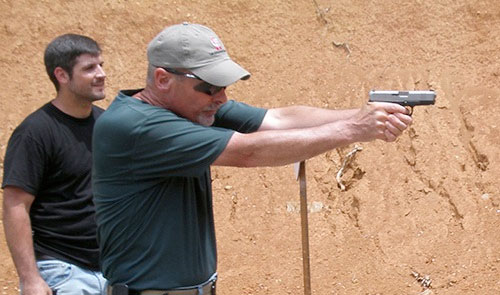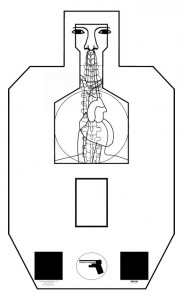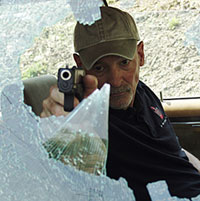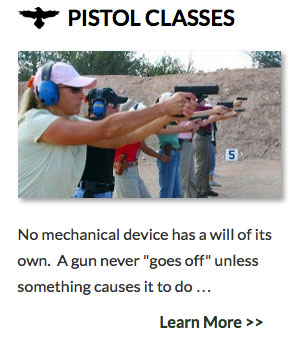Widgetized Section
Go to Admin » Appearance » Widgets » and move Gabfire Widget: Social into that MastheadOverlay zone
What Should I Practice?

One of the more common questions I receive from readers or students is, “What should I practice?” It’s a legitimate question, especially with skyrocketing ammunition prices… if you can find it! Recently, I was at the local Wal-Mart buying some Winchester White Box 9mm ammo (the cheapest I could find at the time and there was only one box) and paid $29.23 for 100 rounds. When I retired from law enforcement in 2004 it was $6.37! No doubt this affects how much and often shooters can train as we all want to keep skills sharp while still paying the mortgage, car payment, buying groceries, clothing and all the other things necessary for daily life. Since blowing up ammo needlessly is certainly recognized as expensive if not just down right foolish, we need to shoot our limited ammo supply wisely. I’m a firm believer in “essentials” (what others call fundamentals), and while many shooters get bored practicing basics, these essential skills are necessary to prevail in conflict. Bruce Lee said, “Advanced skills are the basics mastered,” which, in my mind, history has shown to be true, thus, practicing ESSENTIALS is a great place to spend your hard earned money and limited time.
Dry Fire
Fortunately, many essential skills can be anchored without firing a shot. Dry fire is the best way to improve draw, reload, malfunction clearances (using dummy rounds), shooting around cover (a mirror on the opposing wall can show how much you expose of yourself), one-hand manipulation, unconventional shooting positions (kneeling, prone, supine, fetal, “roll back”, etc.) and any other skill that doesn’t require actual repeated trigger manipulation. The purchase of a dry fire training device can give first shot feedback via a laser fit into the barrel of your carry gun and considering ammo availability, this type of device might soon become a necessity! I am currently working with a prototype unit that not only offers multiple targets (attached to my laptop that “active” at random times and intervals) but also has a drop in trigger so I can work reset. Before beginning any dry fire training program, make double, triple and quadruple sure that your gun is empty and that no live ammo is in the room. A Kevlar dry fire pad, such as the one manufactured by Safe Direction, is a very good idea as is a barrel plug or dry fire replacement barrel like the one made by Blade-Tech, if a laser unit it not used. Such steps will go a long way towards safe dry handgun usage in the event of a “brain fart” which can happen to anyone.
The Real Deal
As stated above, there are very few essential skills that require live fire practice in order to master. When do we need live ammo? The two skills that must be practiced live fire are repeated trigger manipulation and recoil control. Trigger control is weapon control, a skill required for accurate shooting and the most difficult to master. In a nutshell, the index finger on the shooting hand depresses the trigger straight to the rear, working independently of the rest of the hand, without interrupting muzzle to target alignment…no sweat, right?! The word “depress” is accurate as what we are trying to do is “apply a constant pressure to a breaking point”…it is where the term “trigger press” comes from.
Think about how many times a day you open and close your hand, using the thumb and fingers in concert and opposition with one another. By doing so, you can get some idea of how complex the action of separating the index finger really is! Taking this into consideration, is it really hard to understand why shooters squeeze their whole hand when they shoot, something I call “milking the grip” as it reminds me of my attempts to milk the teat on a cow…squeezing while pulling down. Independent trigger depression requires intense concentration and needs to be mastered before all other skills. It must be practiced regularly, as it might be the most perishable of a skill sets that are very perishable in themselves. Luckily, recoil control isn’t quite as difficult and is really a function of proper grip, inward hand pressure and upper body position applying forward force to the handgun. If the front sight is not returning to the target on its own, then you need to correct your grip and body position.
To the Range
With the above concepts in mind as I head to the range, I start out with a few timed drills to see where I’m at. What I am going to suggest is merely that…a suggestion! If you have a practice regime that works, leave it alone. I like to do these drills “cold,” as I believe they are a better indicator of performance than after I have shot for a while. Remember, it’s unlikely you’ll have just come from a range session when your gunfight occurs. You’ll more than likely be “cold” …make that frigid!
 I shoot these drills at 20 feet on a target of my own design, the HCT-01 available from Law Enforcement Targets. IPSC, IDPA, CSAT, Viking Tactics or any other popular target that restricts shots to the high chest region can be used, however. Only hits in the high chest count as shot placement is the single most important factor for rapid incapacitation with any small arm. I consider live fire a confirmation of my dry practice drills so I do each drill twice—anyone can get lucky and perform a single drill well. Once is luck, twice is more likely to be skill.
I shoot these drills at 20 feet on a target of my own design, the HCT-01 available from Law Enforcement Targets. IPSC, IDPA, CSAT, Viking Tactics or any other popular target that restricts shots to the high chest region can be used, however. Only hits in the high chest count as shot placement is the single most important factor for rapid incapacitation with any small arm. I consider live fire a confirmation of my dry practice drills so I do each drill twice—anyone can get lucky and perform a single drill well. Once is luck, twice is more likely to be skill.
The drills are as follows:
- One shot from ready in 1 second
- Four rounds from ready in 2 seconds (first shot in 1 second, subsequent shots .33,.33,.33 or less)
- One shot from a concealed holster in 2 seconds (1.5 preferred)
- One shot, reload, one shot in 3 seconds
- Draw, two shots, reload, two shots on two targets in 4 seconds
These drills take 15 minutes and consume 24 rounds and give me an idea of where I am lacking and what essential(s) to work on. The key is not to become a “slave” to the timer and shoot faster than you can hit! A “lucky run” isn’t educational, only deceiving. These drills should be learning points, not ego gratifiers. I believe it is important, no critical, to think about why you train. Be honest, if it is for your personal security then your training is not practice…its preparation! Keep this in mind…
Trigger Focus
I then shoot several magazines focusing on trigger control, which, as previously stated, is one area where dry fire does not totally suffice. I start at 10 feet; shooting three inch squares on the bottom of the HCT-01 target, going agonizingly slow with no time limit, trying to shoot one jagged hole. I focus (a very important word when practicing!) completely on what my hands are doing…specifically my trigger finger…making them control the trigger and not milking the entire grip, find the reset point and then smoothly depressing through the trigger action. Like many people as I shoot I have a tendency to allow my support hand to loosen up, so I try hard to keep it tight. I also take note of my body position, making sure my shoulders are forward “into” the gun. I move back 5 feet at a time, shooting 3 rounds at each distance, trying to stay on the 3″ square, concentrating on “sight, press” while working my way back to 50 feet and then shoot at 20 and 25 yards. If I miss a round I shoot it again until I get it on the square. I can generally keep all rounds in the square until I get back to 20 yards where the front sight completely hides it; at that point if I am in/around the square by a few inches I am satisfied. I call this drill “Three Round Fadeback” and I use it in all of my classes as a warm up drill. By now I have usually fired between 50 and 60 rounds.
More Practice
If I have additional ammo available, I then work on delivering the gun to the target from one of several “ready” positions, ensuring the delivery is consistent and feels right as the felt aspects of shooting are grossly under-rated! I then move to the draw stroke, making sure it’s consistent and direct to the target… I also work on picking up the front sight in my field of vision as quickly as possible. Make sure you practice with the same carry gear that you use daily, including a concealing garment. Add a few drills which simulate combat conditions including movement, kneeling, supine or from extreme close quarters and you will have a reasonable 200-round practice session. Keep in mind these are the same things I work on dry fire so I keep continuity.
No, these drills do not account for all of what might happen in a gunfight, but understand there’s no way to prepare for every possible thing that could happen in an armed confrontation. History has shown the person who prevails in armed conflict is the one who can keep his/her head and adapt their practiced skills to the problem faced. The police officer or armed citizen that never practices is the one who will fail to adapt and, of course, this could be fatal. Stay safe, stay alert and practice your skills often. Remember, practice should be training and training is preparation!
About the author:
 Dave Spaulding is the 2010 Law Officer Trainer of the Year and Law Officer’s Firearms columnist. A 36-year law enforcement and private security veteran, he retired at the rank of lieutenant. He is the founder of Handgun Combatives a training institution that focuses on the combative application of the handgun. He has worked in corrections, communications, patrol, evidence collection, investigations, undercover operations, training and SWAT—and has authored more than 1,000 articles for various firearms and law enforcement periodicals. He is also a graduate of most of the nation’s best known shooting schools. He’s also the author of the best-selling books Defensive Living and Handgun Combatives. Visit his web site at www.handguncombatives.com and like him on Facebook. His DVDs “Handgun Combatives are also available on Paladin Press. His latest DVDS “Situational Combative Pistols” and “Comabitive Pistolcraft Essentials” are available on Panteao Productions.
Dave Spaulding is the 2010 Law Officer Trainer of the Year and Law Officer’s Firearms columnist. A 36-year law enforcement and private security veteran, he retired at the rank of lieutenant. He is the founder of Handgun Combatives a training institution that focuses on the combative application of the handgun. He has worked in corrections, communications, patrol, evidence collection, investigations, undercover operations, training and SWAT—and has authored more than 1,000 articles for various firearms and law enforcement periodicals. He is also a graduate of most of the nation’s best known shooting schools. He’s also the author of the best-selling books Defensive Living and Handgun Combatives. Visit his web site at www.handguncombatives.com and like him on Facebook. His DVDs “Handgun Combatives are also available on Paladin Press. His latest DVDS “Situational Combative Pistols” and “Comabitive Pistolcraft Essentials” are available on Panteao Productions.



 MidwayUSA
MidwayUSA Ruger Firearms
Ruger Firearms SCCY Firearms
SCCY Firearms Streamlight
Streamlight Action Targets
Action Targets Gunsite Academy
Gunsite Academy
You must be logged in to post a comment Login